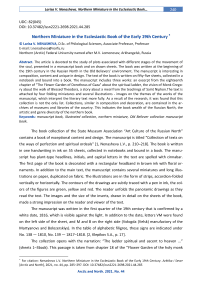Northern Miniature in the Ecclesiastic Book of the Early 19th Century
Автор: Nenasheva L.V.
Журнал: Arctic and North @arctic-and-north
Рубрика: Reviews and reports
Статья в выпуске: 44, 2021 года.
Бесплатный доступ
The article is devoted to the study of plots associated with different stages of the movement of the soul, presented in a manuscript book and on drawn sheets. The book was written at the beginning of the 19th century in the Russian North in the Old Believers' environment. The manuscript is interesting in composition, content and unique in design. The text of the book is written on fifty-five sheets, collected in a notebook and bound into a book. The manuscript includes three works: an excerpt from the eighteenth chapter of "The Flower Garden of Dorotheus of Gaza" about the spiritual ladder, the vision of Monk Gregory about the walk of Blessed Theodora, a story about a meal from the teachings of Saint Niphon.The text is attached by four folding miniatures and several illustrations - images on the themes of the works of the manuscript, which interpret the literary text more fully. As a result of the research, it was found that this collection is not the only list. Collections, similar in composition and decoration, are contained in the archives of museums and libraries of the country. This indicates the book wealth of the Russian North, the artistic and genre diversity of the northern book.
Manuscript book, illustrated collection, northern miniature, Old Believer collection manuscript book
Короткий адрес: https://sciup.org/148322055
IDR: 148322055 | УДК: 82(045) | DOI: 10.37482/issn2221-2698.2021.44.285
Текст научной статьи Northern Miniature in the Ecclesiastic Book of the Early 19th Century
The book collection of the State Museum Association “Art Culture of the Russian North” contains a book of exceptional content and design. The manuscript is titled “Collection of texts on the ways of perfection and spiritual ordeals” [1, Nenasheva L.V., p. 210–218]. The book is written in one handwriting in ink on 55 sheets, collected in notebooks and bound in a book. The manuscript has plant-type headlines, initials, and capital letters in the text are spelled with cinnabar. The first page of the book is decorated with a rectangular headband in brown ink with floral ornaments. In addition to the main text, the manuscript contains several miniatures and long illustrations on paper, duplicated on fabric. The illustrations are in the form of strips, accordion-folded vertically or horizontally. The contours of the drawings are subtly traced with a pen in ink, the colors of the figures are green, yellow and red. The reader unfolds the panoramic drawings as they read the text. The images and the size of the inserts, drawn in detail on the sheets of the book, made a strong impression on the reader and viewer of the text.
The manuscript was written in the first quarter of the 19th century that is confirmed by a white date, 1816, which is visible against the light. In addition to the date, letters VM were found on the left side of the sheet, and M and B on the right side (Vologda (Velsk) manufactory of the Martyanovs and Bolozerskiys). In the table of alphabetic filigree, these signs are indicated under No. 138 — 1810, No. 139 — 1817–1818. [2, Klepikov S.A., p. 17].
The collection opens with the narration: “The ladder spiritual and ascent to heaven ...” (sheets 1–3back). This passage is taken from chapter 18 of the “Flower Garden of the holy monk
Abba Dorotheus”. The main idea of this passage is self-improvement and spiritual purification, a gradual ascent up the ladder of righteous life. The author encourages the reader to walk constantly up the spiritual and rising stairs to heaven. In the interpretation, the author explains that the steps of the spiritual ladder leading to heaven are the Lord’s commandments and the virtues of the Father. Whoever goes along that staircase, one step at a time, ascends upward. Whoever steps in two or three ones — slips and falls to the ground again and crashes. So are the commandments and virtues: whoever bypasses the first commandments, will not summit the latter ones. The text is illustrated with a miniature in the form of a key to the gate from the Kingdom of Heaven (Fig. 1).

Fig. 1. The key to the gates of the kingdom of heaven (ladder of the 60 commandments).
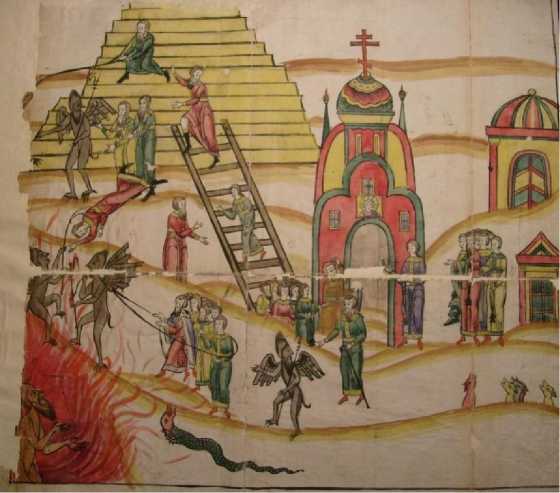
Fig. 2. The lower part of the key (bit).
The middle part of the key (rod) is a staircase of 60 numbered steps. The image of the ladder goes back to the famous vision in Jacob's dream from the book of Genesis, chapter 28. The image of the ladder is central to the work of John of Sinai, which was written as a guide to monastic life — “Lestvitsa” (“The Ladder”). “Lestvitsa” was a popular and beloved book in Russia, plots from it were drawn by Russian writers and poets, some chapters from it were published in prerevolutionary magazines for home reading, for pedagogical education [3, Nenasheva L.V., p. 159]. As noted by R.V. Bagdasarov, “in Russia “Lestvitsa” of John of Sinai acquired special popularity during the ascetic rise of the 14th–15th centuries” [4, Bagdasarov R.V., p. 7]. In the “Lestvitsa”, before the beginning of the main text and in other early Russian manuscripts, a staircase of thirty steps was depicted according to the number of years of Jesus Christ’s life before baptism, “then the image of monks climbing the steps and demons interfering with them is increasingly spreading”. And the number of steps increases to sixty [4, Bagdasarov R.V., p. 7].
In our miniature, nine people climb the steps at different heights. To the right of the steps, the beginning of the New Testament commandment with its number is written in column. And here, on the steps, the struggle for human souls continues. Five people successfully climb the stairs of the commandments, their heads are raised, their eyes directed upward. The demons are trying to knock three companions down the stairs (two of them — with a stick, the third one is be- ing poked in the back with sharp hooks), so those descending are drawn face down, uncertainly stepping onto the rung of the stairs. One of the climbers is trying to maintain balance and not to break down. This image most likely symbolizes a person insecure in himself and in his actions, weak to temptations and not always keeping the commandments, so his fall is inevitable (Fig. 3, 4).
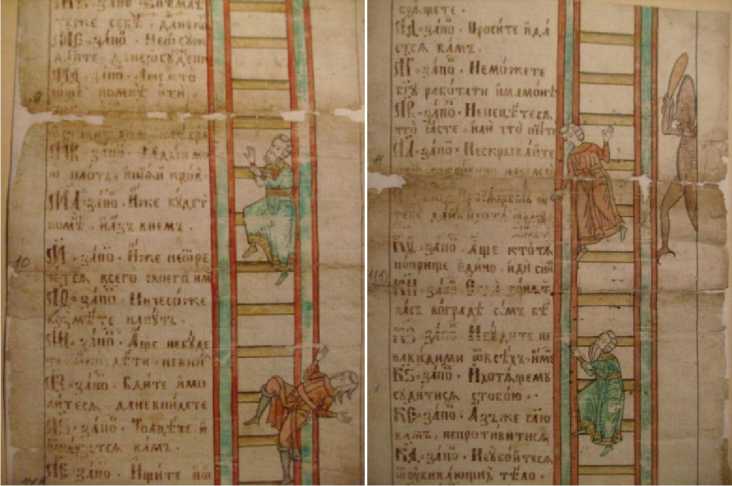
Fig. 3. Ladder of the 60 commandments. Fig. 4. Ladder of the 60 commandments
(key rod).
The artist placed the Kingdom of Heaven in the grip of the key; the ladder of the commandments reaches up to the Lord’s gates. The Lord on the throne rises in the center of the heavenly city. He holds an open Gospel with his left hand, the fingers of his right hand are folded in a two-fingered sign. Behind the back of the Savior is a shining hemisphere, behind which are the angelic figures on either side. On the right side of the throne are figures with beardless faces (young men and, possibly, women), on the left — bearded ones. The lower part of the miniature shows the city walls of houses that make up a single whole, with windows lined in a cage, with beautiful gates and figured columns on the sides — a characteristic image of the heavenly city in northern Old Believer manuscripts. A young man and an old man stand at the city gate. Five houses are drawn on the edges of the picture, figures of saints can be seen in four of them. “The symbolism and form of the picture are transparent. The kingdom of heaven opens with the key of God's commandments. <...> The key is intended for the door, and there is no doubt that the compilers of the plot were well aware of this “door” [4, Bagdasarov R.V., p. 10] (Fig. 5).
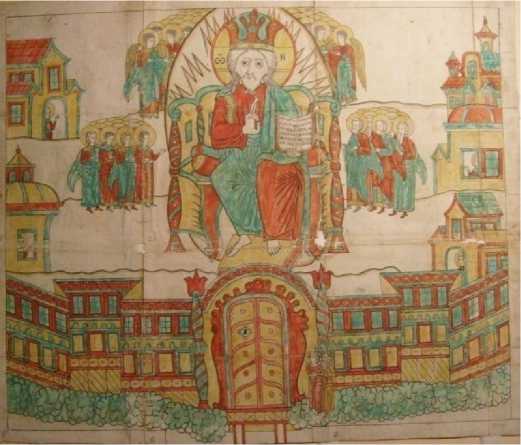
Fig. 5. Kingdom of heaven (key grip).
The handwritten sheets 7–29back contain a text from the hagiography of St. Basil the New on the tollhouse of Blessed Theodora. The text tells how Saint Theodora, after her death, underwent 21 aerial tollhouses and announced it in a dream vision to the disciple of the monk of Basil the New — Gregory. Theodora was a novice of the monk Gregory. After her death, he cared greatly for the novice and prayed for her soul, and in a dream, he succeeded to see Theodora’s afterlife. The story of the monk Gregory about walking through the tollhouses of Blessed Theodora is included in the Hagiography of Basil the New, who lived in Byzantium in the 10th century. The translation of the Hagiography into the Slavic language was made in Russia at the end of the 11th century. From the second half of the 17th century, personal lists of the visions of the monk Gregory and the tollhouses of the Monk Theodora are widely circulated among the Old Believers, and since the 18th century, these plots are often found in Old Believer popular prints and drawn sheets, especially in the Russian North [5, Orthodox encyclopedia, p. 210–212].
Theodora’s story begins with the fact that she dies of an illness, and at that moment many demons (in the text — Ethiopians) come to her bedside with a charter, in which Theodora’s deeds from her youth are written. On the right side of the bed, there are two angels accompanying the soul of Theodora. Then death comes in the form of a skeleton with a scythe in his left hand and an ax in his right hand. It has various tools in the shoulder bag: swords, knives, saws, sickles, arrows. Death cuts off Theodora's legs with a small axe, then her hands, destroys her joints and nails, and finally cuts off her head. The miniature shows how the soul of Theodora moved away from the body and the young angels took it into their hands (Fig. 6).

Fig. 6. Moving of the Theodora’s soul away from her body.
Further, in the text, Theodora tells the monk Gregory about the walking of her soul through the tollhouses, about the struggle of angels for the salvation of her soul. The tollhouses of Theodora are vividly described: they follow each other, from bottom to top, like the steps of a ladder and are located on clouds, where one or more demons are located with a box with rolled scrolls inside. The soul of the novice is placed in the hands of two angels who accompany her and try to protect her from evil demons. These chapters are illustrated with drawings for the walk of the Monk Theodora through the air tollhouses (Fig. 7). The reader was able to get acquainted visually with such tollhouses as slander, abuse, envy, lies, anger, pride, idle talk and foul language, recklessness and flattery, drunkenness, rancor, gluttony, fornication, etc. The text is illustrated with two folding miniatures. The soul of Theodora undergoes twenty-one tollhouses, which is described in detail in the book and depicted in the figures (Fig. 8, 9).
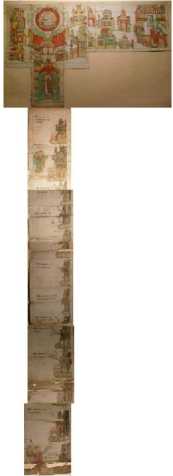
Fig. 7. The ladder of tollhouses.
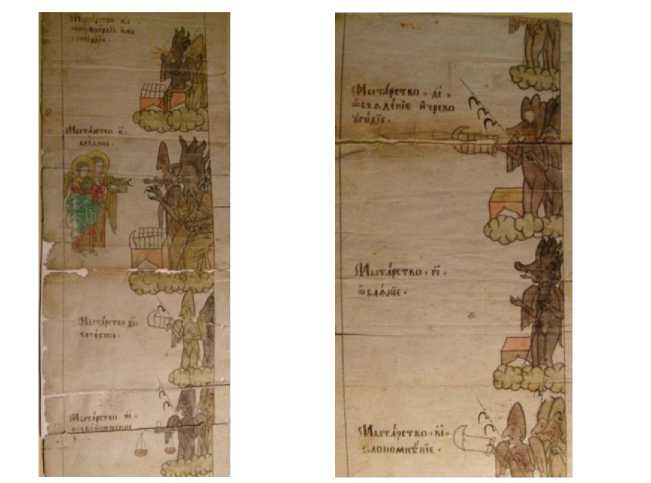
Fig. 8. Tollhouses 18–21. Fig. 9. Tollhouses 12–14.
Blessed Theodora’s tollhouses end happily: the angels succeed in saving her soul from the demons, who could not find the grave sins she had committed while a novice. Further Theodora says: “We joyfully departed from the demons, approached the heavenly gates and entered them”. She then describes in detail the heavenly kingdom and her joy in the heavenly abode. The miniature depicts habitats, typical for northern drawings. Saints look out the windows everywhere. Angels carry the soul of Theodora, and all the saints rejoice at her salvation, and the angels say to her: “You see, Theodora, from what torments the Lord delivered you through the prayers of Saint Basil”. On the right side, the Monk Basil is depicted sitting on the throne. He meets the soul of Theodora forty days after her separation from the body (Fig. 10).
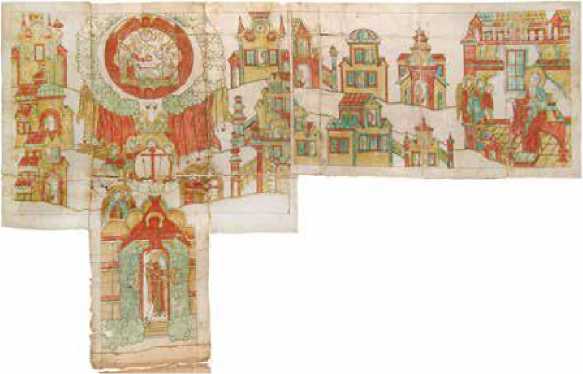
Fig. 10. Heavenly abode.
Another folding miniature shows drawings depicting souls held in tollhouses (a sequence of drawings from top to bottom), turning into an image of the entrance to hellfire and the throne of Satan (Fig. 11–14).
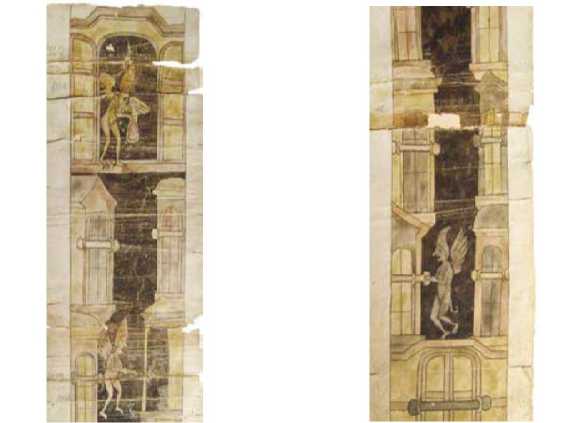
Fig. 11. Fragment of fig. 13.
Fig. 12. Fragment of fig. 13.
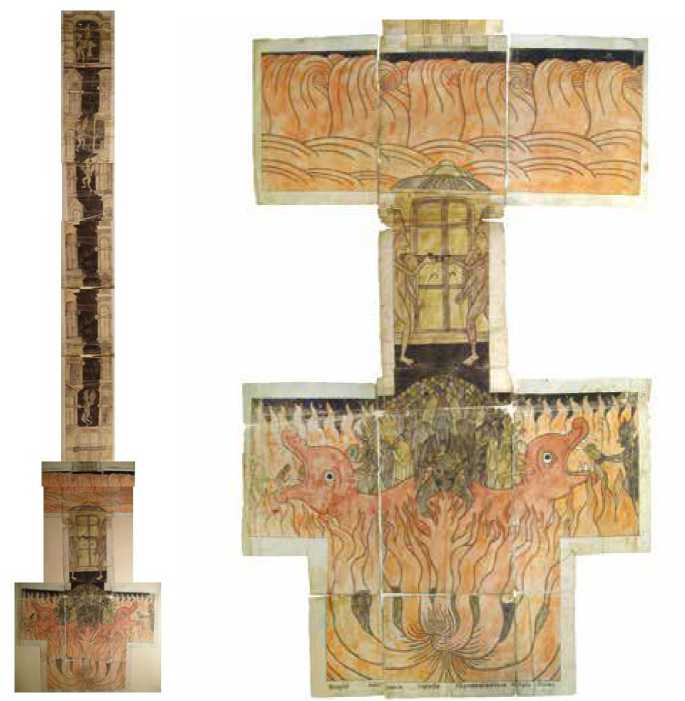
Fig. 13. Fall into hellfire. Fig. 14. Hellfire.
On sheets 31–39 back, a story was written on behalf of the monk Gregory: “The saints enter the joy of the Lord”. All the ranks of the saints are shown in groups on a long ribbon. The enumeration of the ranks of the saints in the text and on the ribbon miniature begins with the Mother of God, ends with the immaculate wives. The list contains seventy disciples, twelve apostles, righteous Abraham, Isaac and Jacob, prophets, merciful and poor. The faces of the righteous were “red, white and blushing”, their clothes were white or colored with cheerful, bright colors — green, yellow and red. The groups of the righteous in the drawing are accompanied by inscriptions (Fig. 15–18).

Fig. 15. The saints enter the joy of the Lord.
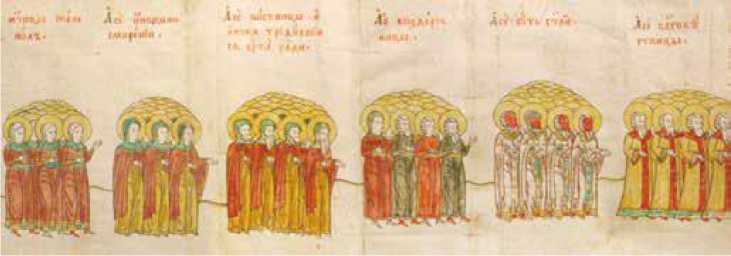
Fig. 16. Fragment of fig. 15.
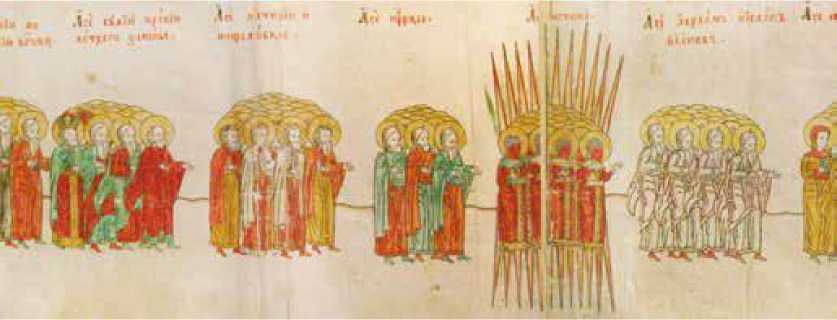
Fig. 17. Fragment of fig. 15.
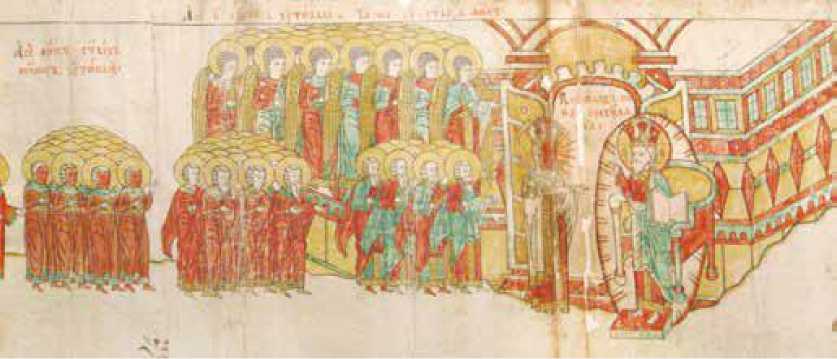
Fig. 18. Fragment of fig. 15.
The beauty of the righteous is contrasted with the ugliness of sinners: robbers, thieves, adulterers, angry, ardent, vindictive, apostates, suicides. And, as the author writes in the book: “There were many of them all over the Earth, ‘like the sand of the sea from Adam’”. This is written in the book on sheets 41–52. The text is also illustrated by a folding ribbon miniature depicting groups of sinners who are captured and thrown into the river of fire by young angels (Fig. 19–21).

Fig. 19. The sea of fire.

Fig. 20. Fragment of fig. 19.
Fig. 21. Fragment of fig. 19.
The last two folios, pages 54-55, present a short edifying story about the meal of the pious and the wicked: “The lection of our holy father Niphont, as it is proper for Orthodox Christians to eat in silence”, which is read at the service on Saturday of the fourth week of Great Lent. This chapter is also illustrated. One sheet depicts a dinner, during which modest beggars are sitting at the table, they are honored with the presence of the angels themselves and therefore, in silence and humility, they have the meal. Another sheet depicts the rich sitting at the meal, at dinner they started idly talks, angry speeches, dissatisfaction with food, they behave violently, so the angel left them, anddark demons came instead of them and began to spread evil among the diners and pour “malicious smoke” on them (Fig. 22). The story of the meal, illustrated in miniature, is often found in northern Old Believer collections.
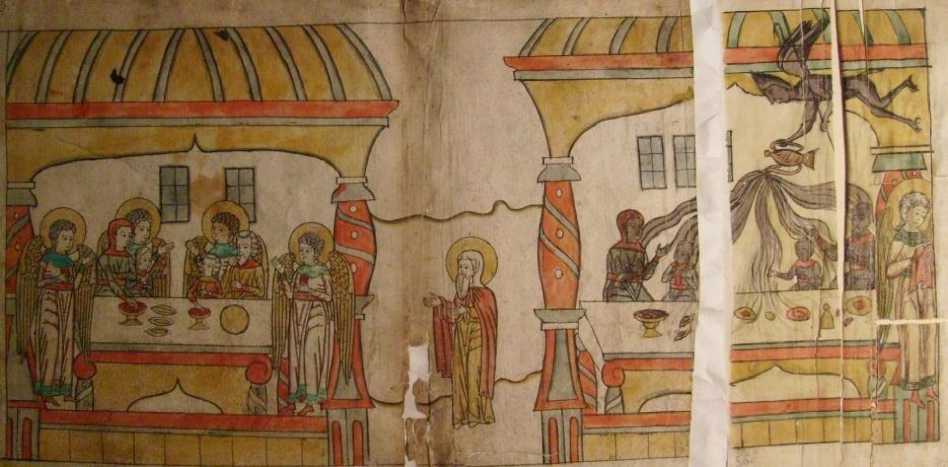
Fig. 22. The meal of the pious and the wicked.
This list is not the only one in the museum association “Artistic Culture of the Russian North”. The funds of the State Russian Museum contain a manuscript monument, which was acquired in 1967 by N.V. Taranovskaya in Nizhnyaya Toyma on the Northern Dvina, in the village of Velikiy Dvor. As noted by N.V. Taranovskaya, “the book is a collection of an eschatological nature, including four narratives on 52 pages, written in half-running hand”. The book also contains illustrations in the form of long folding strips. N.V. Taranovskaya calls this list the “Spiritual Ladder” after the name of the initial chapter, and dates it to the second half or the end of the 19th century, since the text and drawings were made on the paper of the Sumkin heritage factory No. 6 [6, Taranovskaya N.V., p. 118]. The so-called Spiritual Ladder from the Russian Museum is very similar to the manuscript created in the first quarter of the 19th century, kept in Arkhangelsk Museum, in composition, content, plots and manner of illustrations.
Copies of drawings, similar to the illustrations in our book, are also given in the article by R.V. Bagdasarov, where he explores the plots presented on the drawn sheets of the mid–late 19th century from the collection of Archpriest Vladislav Provotorov (Pavlovskaya Sloboda, Moscow Oblast) [4, Bagdasarov R.V., p. 3]. According to R.V. Bagdasarov, the plots of these pictures were cop- ied from the drawn sheets that belonged to Nikolai Prokopyevich Shestakov, who lived in the village of Izosimovo, Belosludskiy camp (now it is Krasnoborskiy district of the Arkhangelsk Oblast) [4, Bagdasarov R.V., p. 4]. N.P. Shestakov is known as a scribe of books, one of the last icon painters on the Northern Dvina [7, Budaragin V.P., p. 404].
Perhaps the manuscript from the Russian Museum was copied from our literary monument. Then our list could not be fulfilled by N.P. Shestakov, since researchers know his works of the late 19th–first third of the 20th centuries. [7, Budaragin V.P., p. 404].
The manuscript from the Russian Museum also begins with the narrative “The Spiritual Ladder and Ascent to Heaven”, and, as N.V. Taranovskaya writes, “the text of the first narrative of our manuscript gave it a name” [6, Taranovskaya NV, p. 118]. The collection also ends with a story about the meal of the pious and the wicked, “the plot, which is reflected in the Domostroy, in basten prints” [6, Taranovskaya N.V., p. 122]. A key to the gate to the kingdom of heaven is drawn to the sheets of text. The drawing of the key is very similar to the drawing from our book. It can be assumed that the pictures of miniatures that we discovered in scientific literature are very similar to the miniatures of the museum manuscript, which means that the miniatures presented in the museum book, as well as in the manuscripts in the collection of the Russian Museum and a private collection, are written in the same book workshop, in the north, in the Old Believer environment.
The miniatures in the three books show common features, “peculiar only to the manuscripts of Severodvinsk” [7, Budaragin V.P., p. 402]. “The Severodvinsk master, who is usually represented as a carpenter, woodcarver, ornamentalist-painter, turns out to be an excellent calligrapher, graphic artist, bibliophile, as well as an icon painter, that is, a master in the broad sense of the word and a spiritual mentor, a teacher of life” [6, Taranovskaya N.V., p. 117]. Therefore, the plots of miniatures, presented in these lists, are found on drawn sheets, on icons, in popular prints created in the Severodvinsk art workshops.
Список литературы Northern Miniature in the Ecclesiastic Book of the Early 19th Century
- Nenasheva L.V. Rukopisnaya kniga Russkogo Severa XV XX vv. v sobranii Gosudarstvennogo muzeynogo ob"edineniya “Khudozhestvennaya kul'tura Russkogo Severa”. Nauchnyy katalog [Manu-script Book of the Russian North of the 15th 20th Centuries in the Collection of the State Muse-um Association "Artistic Culture of the Russian North". Scientific Catalog]. Moscow, Severnyy pal-omnik Publ., 2019, 392 p. (In Russ.)
- Klepikov S.A. Filigrani na bumage russkogo proizvodstva XVIII nachala XX veka [Filigree on Rus-sian made Paper of the 18th Early 20th Centuries]. Moscow, 1978, 239 p. (In Russ.)
- Nenasheva L.V. No Righteous Man Exists Without Honoring Books. Manuscript Book of the Russian North of the 15th 20th Centuries (Exhibition Materials). Arktika i Sever [Arctic and North], 2020, no. 38, pp. 155 166. DOI: 10.37482/issn2221 2698.2020.38.152.
- Bagdasarov R.V. Dvizheniya dushi. Risovannye listy russkikh ctaroobryadtsev. XIX vek [Movements of the Soul. Drawn Sheets of Russian Old Believers. XIX Century]. Usolye, Usolye Historical and Archi-tectural Museum “Stroganov Chambers”, 2010, 72 p. (In Russ.)
- Orthodox encyclopedia. Vol. 7. Vasiliy Novyy. Moscow, 2004, pp. 210 212. (In Russ.)
- Taranovskaya N.V. “Lestvitsa dukhovnaya pamyatnik rukopisnoy knizhnoy traditsii Severnoy Dviny”. Chteniya po issledovaniyu i restavratsii pamyatnikov khudozhestvennoy kul'tury Severnoy Ru-si, posvyashchennye pamyati khudozhnika restavratora Nikolaya Vasilyevicha Pertseva 1902 1981 [“The Spiritual Ladder is a Monument to the Manuscript Book Tradition of the Northern Dvina”. Readings on the Study and Restoration of Monuments of the Artistic Culture of Northern Russia, Dedicated to the Memory of the Artist Restorer Nikolai Vasilyevich Pertsev 1902 1981]. Arkhan-gelsk, 1992, pp. 116 125. (In Russ.)
- Budaragin V.P. Severodvinskaya rukopisnaya traditsiya i ee predstaviteli (Po materialam Drevnekhranilishcha Pushkinskogo Doma) [Severodvinsk Manuscript Tradition and Its Representa-tives (Based on the Materials of the Ancient Repository of the Pushkin House)]. Leningrad, 1979, vol. 33, pp. 401 405. (In Russ.)

